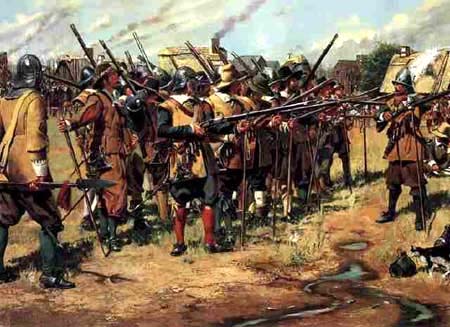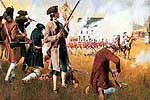The Early Colonial Period
 Soon after the English colonists arrived in the New World, the need to organize for the common defense was realized, and a plan devised to meet the needs of the colonies. The East, North, and South regiments were formed in December of 1636, to provide a means by which the citizens could protect their communities. Today, these regiments live on in the Massachusetts National Guard.
Soon after the English colonists arrived in the New World, the need to organize for the common defense was realized, and a plan devised to meet the needs of the colonies. The East, North, and South regiments were formed in December of 1636, to provide a means by which the citizens could protect their communities. Today, these regiments live on in the Massachusetts National Guard.
Units occaisionally drilled, but were primarily focused on the role of community defense. As English settlements grew, the tensions with the natives increased, culminating in King William's War. This was the first time that such units undertook military activity in larger than company size, and formed the basis of the militia system of the colonies.
Peace between the colonials and natives remained fragile, and the local units rotated duty, patrolling or "ranging" along the frontier. The "ranger" tactics developed during this period would influence colonial military thought for the next 100 years.
The War of Jenkin's Ear marked the first time colonial militia units mustered into British service as a provincial unit and served outside the territorial limits of the colonies. The regiment formed from the Virginia militia, lost some 80% of the men due to sickness and disease, never fired a shot in combat, and the survivors (including George Washington's father) returned to Virginia and were mustered out of service. Other units from Georgia attacked the Spanish at Ft. Augustine in an unsuccessful attempt to take Florida.
Westward expansion of colonial settlements into the Appalaichans, again increased tensions with the native population, and frequent skirmishes took place. The militia system evolved further, with each county being responsible for having a company, and towns starting to establish their own units in addition to the county unit.
The French and Indian War
The Seven Years War marked the first time North America was a battleground in a major conflict between European powers. This conflict also saw the first time that the British Army stationed troops on the regular establishment in the American colonies. Previously, all military activity had been undertaken by the colonists themselves under the militia system.
Extensive use was made of militia units, some of them being incorporated into provincial regiments, and also supplied recruits for the Royal American Regiment, which became the 60th Foot in the regular British Army, and the Royal Americans live on today as part of the Rifle Regiment. Benjamin Franklin was key in organizing the Associated Regiment of Philadelphia (which lives on in the 111th Infantry and 103rd Artillery Regiments of the Pennsylvania National Guard).
Tensions between the officers of militia and provencial units and the officers of the British Army increased and although the British were victorious, the military effectiveness of the British effort suffered from these tensions. Many colonial officers, including George Washington, resigned from service due to differences in opinion as to proper strategy and tactics. These feelings of being slighted by the regulars and the now permanent presence of British Army units in North America, combined with the insistance of the government that the colonials pay for the military protection that they had customarily provided for themselves, increased political tensions.
The increased political tensions between the American colinies and the British government manifested itself with a passionate interest in revitalizing the militia of the colonies. The Boston Cadets chose John Hancock as commander in 1772, and the Fairfax County militia was commanded by George Washington. Thomas Jefferson was already serving as County Lieutennant of the Albemarle County militia.
The American Revolution
 On April 14, 1775, General Thomas Gage received instructions from Secretary of State William Legge, the Earl of Dartmouth to disarm the colonial militia, who were known to have hidden cannon and gunpowder in Concord, and to arrest the leaders of the "rebellion". On April 18th, troops were assembled and a mounted patrol sent toward Concord. That evening, the Lexington militia mustered. As the British column moved on Concord, militia units continued to muster. The confrontation took place at Concord, and despite the efforts of commanders on both sides not to initiate violence, the American Revolution had begun.
On April 14, 1775, General Thomas Gage received instructions from Secretary of State William Legge, the Earl of Dartmouth to disarm the colonial militia, who were known to have hidden cannon and gunpowder in Concord, and to arrest the leaders of the "rebellion". On April 18th, troops were assembled and a mounted patrol sent toward Concord. That evening, the Lexington militia mustered. As the British column moved on Concord, militia units continued to muster. The confrontation took place at Concord, and despite the efforts of commanders on both sides not to initiate violence, the American Revolution had begun.
Militia units arrived to lay siege to the British Army at Boston. As the colonials worked to lay siege and build an army, the British took the initiative at the battle of Bunker Hill with devestating consequences. A professional army had attacked an army comprised only of militia units in a prepared defense, and suffered debilitating losses in forcing the colonials out of their positions.
These events led to many new military units being formed by citizens and then offering the services of the unit to the cause. The Philidelphia City Troop formed from leading citizens of the city, who at their own expense equipped a cavalry troop. This Troop became the bodyguard of George Washington.
Militia units performed the bulk of the fighting in the Continential Army, until the Line was built, starting at Valley Forge. As the war went on for years, the bulk of the Army became more professionalized and militia units became a local, short term suppliment to the long term volunteer forces, which were built from a core of militia units. By the Battle of Cowpens, the winning formula of using militia and regulars had been found.
The Early Federal Period
The adoption of the Constitution in 1789, gave Congress the authority to call forth the militia for federal duty and prescribe standards for the state run militias. This kept in place the basic formula from the Revolution, that the state militias would have the bulk of the manpower from which a national army would be built during wartime. The Militia Act of 1792 (amended in 1795) provided the basic set of laws under which the militia acted until 1903.
The Militia Act specified the organizational structure of the state militias into companies, regiments, and brigades, requiring the enrollment of every male citizen between 17 and 45 capable of bearing arms. The county became the basic political unit which tended to align with a militia company, with cities tending to provide additional mounted or artillery companies. Unitis in cities also tended to form around political associations, some units such as the Philadelphia City Troop, being federalist (declining to turn out when Jefferson visited), while other units were formed from anti-federalists.
Individuals were required by the Militia Act to equip themselves, at their own expense, with a .69 cal military musket or rifle, and provide the basic set of gear for a soldier - cartridge box, canteen, haversack, pack, and blanket. While some units took pride in their unit and drilled regularly to gain proficiency (including adopting uniforms and pattern equipment), others met as seldom as once per year, in order to complete and turn in a muster roll.